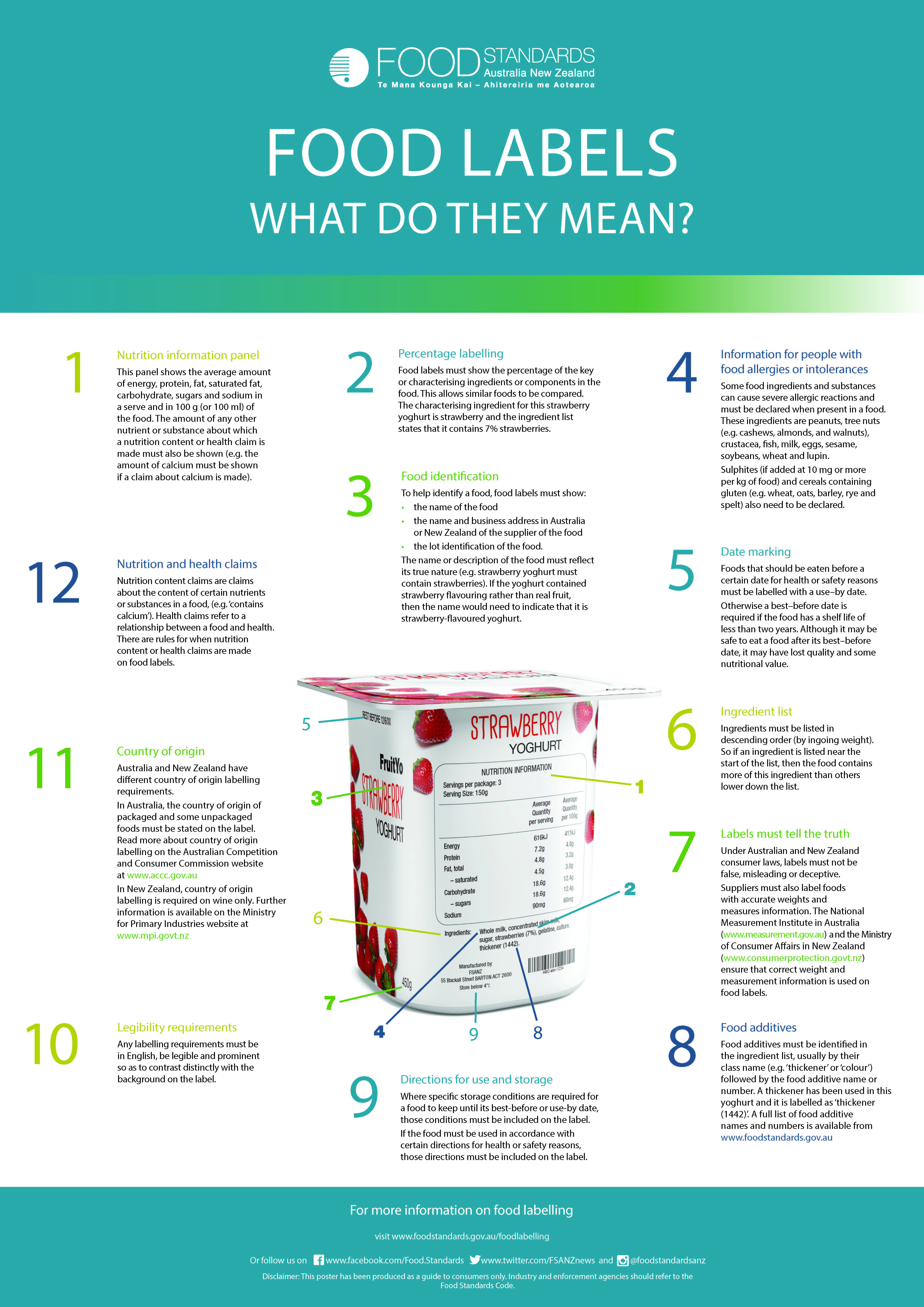45 article on food labels
Food and Drug Administration - Wikipedia The United States Food and Drug Administration (FDA or USFDA) is a federal agency of the Department of Health and Human Services.The FDA is responsible for protecting and promoting public health through the control and supervision of food safety, tobacco products, dietary supplements, prescription and over-the-counter pharmaceutical drugs (medications), vaccines, biopharmaceuticals, blood ... Understanding and use of food labeling systems among Whites and Latinos ... Most governments require at least one type of food labeling system on packaged foods to communicate nutrition information and promote healthy eating. This study evaluated adult consumer understanding and use of nutrition labeling systems in the US and Mexico, the most obese countries in the world. Methods,
Why Is Reading Food Labels Important? | livestrong The nutrition label provides key information such as serving size, calories, total fat, saturated fat, cholesterol, protein, carbohydrate and vitamin content. The label also contains a list of the ingredients. This information helps you stay on track with your daily targets.
Article on food labels
The Truth Behind Food Labels | Audubon Since 2003 U.S. organic food sales have more than doubled, to roughly $25 billion. The booming demand for organic foods is making greenwashing more tempting—and more lucrative—than ever before. One study found that about a third of all new food products launched in 2008 claimed to be "natural.". Food Labeling Basics - Food Quality & Safety The first job of a food label is to catch the consumer's eye. A good label makes us want to try what's inside the package. A label accomplishes this by being attractive and by telling the product's story. What is it? Why should we want to buy and eat it? The story may vary a great deal depending on the product. How To Read Food and Beverage Labels - National Institute on Aging Although frozen and canned fruits and vegetables have food labels, fresh varieties often do not. You can find nutrition information for fresh vegetables and fruits on the USDA website. Or you can call the U.S. Department of Agriculture's Food and Nutrition Information Center at 301-504-5414. Understanding percent Daily Value (% DV)
Article on food labels. USDA ERS - Food Labeling The Nutrition Facts Label (NFL), mandated through the 1990 Nutrition Labeling and Education Act (NLEA), is a familiar feature on packaged food. The label has changed only slightly since its inception in 1994, with trans fat added in 2006 to the nutrients required to be listed. In a 2012 report, ERS researchers found that between 2005 and 2010 ... What misleading food labels such as 'less processed' and 'multigrain ... Remember that the primary purpose of labels is to get you to buy the food. Manufacturers have a bazillion ways to make you feel good about the food you want to eat anyway. For the most part, the... Understanding Food Nutrition Labels | American Heart Association Here are some tips from the American Heart Association for making the most of the information on food labels. Learn what to look for on the label. 1 - Start with the serving information at the top. This will tell you the size of a single serving and the total number of servings per container (package). How to Understand and Use the Nutrition Facts Label | FDA - U.S. Food ... Overview. The information in the main or top section (see #1-4) of the sample nutrition label (below) can vary with each food and beverage product; it contains product-specific information ...
The Ultimate Guide to Food Labels | EatingWell Low Sodium: The food contains 140 milligrams of sodium or less per serving. Lightly Salted: The item contains 50% less sodium per serving than the standard version of that product. Less Sodium: The item contains at least 25% less sodium per serving compared to the standard version of that product. This is also true for the terms "reduced sodium ... Understanding Food Labels - The Nutrition Source Under the Food Allergen Labeling and Consumer Protection Act of 2004, eight major food allergens—milk, fish, tree nuts, peanuts, shellfish, wheat, eggs, and soybeans—are required to be listed in a "contains" statement near the Ingredients list if present in a food. An example would be "contains wheat, milk, and soy.", How to Read Food Labels Without Being Tricked - Healthline Food labeling regulations are complex, making it harder for consumers to understand them. This article explains how to read food labels so that you can differentiate between mislabeled junk and... The food label series: Do labels help or hurt us? - Precision Nutrition Food labels part 2: Label claims, Manufacturers depend on consumers being rushed, busy, inattentive, and impulsive. Part 2 of our food label series examines the truthfulness, accuracy, and usefulness of label claims, and shares the most important information for you to know about a given product. Click to read Part 2,
Why Lawsuits Over 'Misleading' Food Labels Are Surging - The New York Times Inspectors with the Food Safety and Inspection Service, the U.S.D.A. agency charged with verifying labeling claims, only have jurisdiction over slaughterhouses and meat processing plants, not the... Food supplements | Food Standards Agency Food supplements sold in NI must include a NI or EU address for the food business. If the food business is not in NI or EU, they must include the address of the importer, based in NI or the EU. Food businesses can continue to use an EU, GB or NI address for the FBO on food supplements sold in GB until 30 September 2022. Impact of food labelling systems on food choices and eating behaviours ... Food labels are considered a crucial component of strategies tackling unhealthy diets and obesity. This study aims at assessing the effectiveness of food labelling in increasing the selection of healthier products and in reducing calorie intake. In addition, this study compares the relative effectiveness of traffic light schemes, Guideline ... Food Labels (for Teens) - Nemours KidsHealth Food labels provide more than just nutrition facts. They also tell you what's in a packaged food (i.e., the ingredients). People with food allergies need to check ingredient lists to avoid foods that can cause an allergic reaction. Some food labels also state which country the food came from, whether the food is organic, and certain health claims.
Consumer perspectives on food labels - Oxford Academic Consumers showed high awareness of the information on nutrition labels. When aided, they were most aware of calories (89%), followed by total fat (81%), sodium (75%), sugars (73%), carbohydrates (72%), saturated fat (71%), and cholesterol (66%). This ranking provides insight into the relative importance consumers place on each of these items.
Food labels and their effects on consumers - The Journalist's Resource In Chile, boxes of Trix have lost their cartoon rabbits and gained black warning labels as part of an effort to limit marketing of unhealthy foods to children. In other countries, packaged foods feature stoplight color coding to indicate their relative nutritional value.. The strategies are aimed at combating the ongoing obesity epidemic. According to data from the Organization for Economic ...

Food Label Explanation: www.scripps.com. This infographic can help you better understand food ...
Food labels often mislead consumers | Oklahoma State University Cholesterol-free produce, gluten-free water, natural soda, 100 percent whole-grain cookies and non-GMO carrots are just a few examples of the many claims shoppers may see on the front of food packages in the United States. Many consumers believe these claims mean the food product they are purchasing is healthier for them and their family.
The Importance of Food Labelling | Eufic Food labelling is one way in which consumers can get knowledge about the food they consider buying. Correctly following the information provided on food labels (such as expiry dates, handling instructions and allergy warnings) can help consumers prevent unnecessary food-borne illness and allergic reactions. Expiry dates,
Food Labels | Nutrition.gov Food Labels, Food labels can help you make healthy choices when buying food in grocery stores or restaurants. Labeling Organic Products, USDA, Agricultural Marketing Service, National Organic Program, Learn about organic foods, requirements, and how they are labeled. Calories on the Menu, HHS, Food and Drug Administration,
What's New With Food Labels in 2020 | Allrecipes Manufacturers with $10 million or more in annual food sales now have until Jan. 1, 2020 to switch to the new label. The previous deadline was July 26, 2019. The FDA published final rules on the new Nutrition Facts label for packaged foods on May 27, 2016. These rules are said to reflect new scientific information pertaining to the link between ...
Carbon Food Labels May Be Coming. Here's What They Mean The Financial Times says Denmark has already agreed to setting aside $1.3 million to "develop carbon labelling proposals" before the end of 2022, while food companies like Oatly and Quorn have ...
The Effects of Nutrition Knowledge on Food Label Use: A Review of the ... Support was found for the knowledge-is-power position relating to food label use. Most studies focused on nutrition labels, few included claims and ingredient lists. Nutrition knowledge supported food label use across a range of knowledge measures. More research with representative samples and wider age ranges is needed. Contributor Information,
Food Labeling: MedlinePlus The information on a food label can help you see how a certain food or drink fits into your overall diet. The label lists, per serving,: The number of calories, Fats, including total fat, saturated fat, and trans fat, Cholesterol, Sodium, Carbohydrates, including fiber, total sugar, and added sugar, Protein, Vitamins and Minerals,
Food Package Labeling - an overview | ScienceDirect Topics There are 12 mandatory pieces of information that must be present on all European Union (EU) food labels: product name, list of ingredients, allergens, quantitative ingredient declaration, net quantity, durability dates, storage, instructions for use, business name and address, country of origin, nutritional declaration, and alcoholic strength.
Food Labeling & Nutrition | FDA Food labeling is required for most prepared foods, such as breads, cereals, canned and frozen foods, snacks, desserts, drinks, etc. Nutrition labeling for raw produce (fruits and vegetables) and...
Understanding food labelling and decoding nutrition Labels The internationally accepted definition of a food label is - any tag, brand, mark, pictorial or other descriptive matter, written, printed, stencilled, marked, embossed or impressed on, or ...
How To Read Food and Beverage Labels - National Institute on Aging Although frozen and canned fruits and vegetables have food labels, fresh varieties often do not. You can find nutrition information for fresh vegetables and fruits on the USDA website. Or you can call the U.S. Department of Agriculture's Food and Nutrition Information Center at 301-504-5414. Understanding percent Daily Value (% DV)
Food Labeling Basics - Food Quality & Safety The first job of a food label is to catch the consumer's eye. A good label makes us want to try what's inside the package. A label accomplishes this by being attractive and by telling the product's story. What is it? Why should we want to buy and eat it? The story may vary a great deal depending on the product.
The Truth Behind Food Labels | Audubon Since 2003 U.S. organic food sales have more than doubled, to roughly $25 billion. The booming demand for organic foods is making greenwashing more tempting—and more lucrative—than ever before. One study found that about a third of all new food products launched in 2008 claimed to be "natural.".





















Post a Comment for "45 article on food labels"